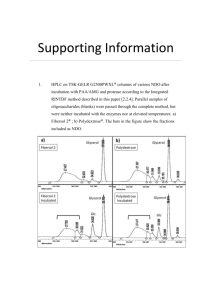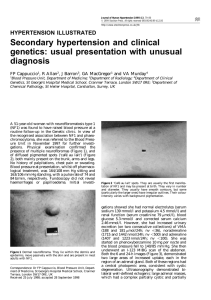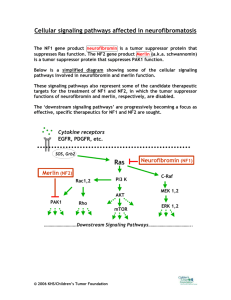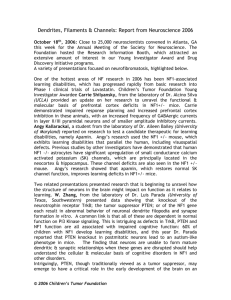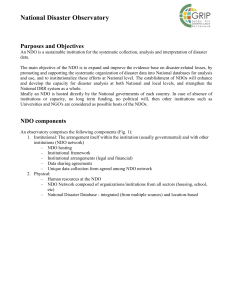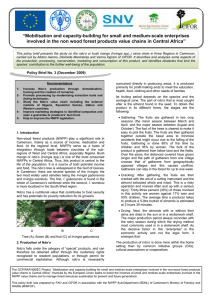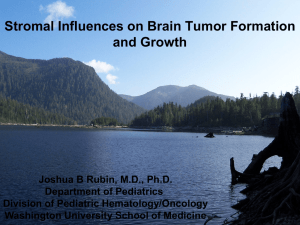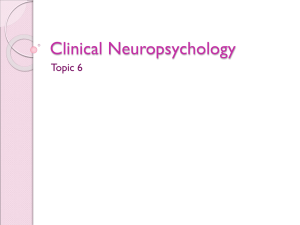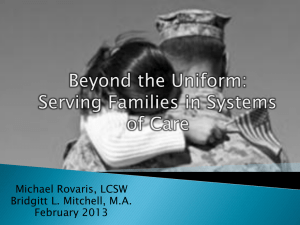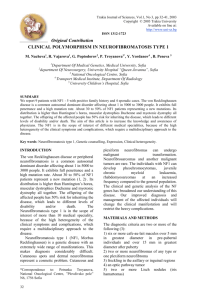Neuropsychology of NF1
advertisement
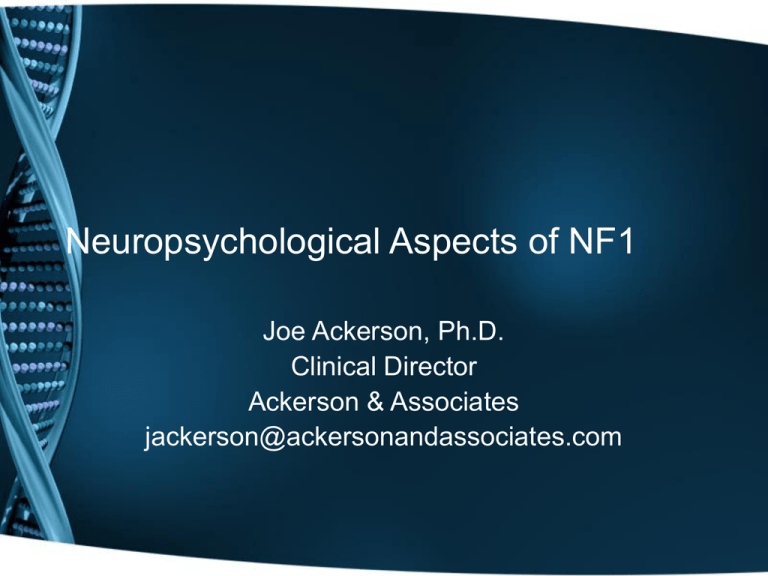
Neuropsychological Aspects of NF1 Joe Ackerson, Ph.D. Clinical Director Ackerson & Associates jackerson@ackersonandassociates.com What is Neuropsychology? • A subspecialty of Clinical Psychology • Specializing in understanding Brain-Behavior Relationships • Applies this knowledge to promote adaptation in the individual • Pediatric Neuropsychology emphasizes a developmental framework and addresses academic and family issues. Relevance of Neuropsychology • • • • • Ability to demonstrate change Rule out alternative explanations Describe neurocognitive profile Identify moderators of functional outcomes Promote realization of one’s future potential Adaptation • The central goal of neuropsychology is to promote adaptation and functioning • Adaptation results from interactions between individuals and their environments • Failures in adaptation may be seen as a matter of a “lack of fit” between the individual and their world Understanding Brain and Behavior • Analysis of brain-behavior relationships provides insights into adaptation • Brain-behavior relationships can be both one-tomany and many-to-one • Understanding these relationships provide a framework for organizing findings • Any complex behavior reflects multiple brain systems Making Predictions • A thorough history is essential (know the past to tell the future) • Assessment should help anticipate the future, not just describe present • Explain adaptive failures and predict risk in terms of mismatch Impact of NF1 on the Developing Brain • Defining NF1 • Domains of functioning • Recommendations for success NF1 • Common autosomal dominant, genetic disorder. • Multi-system: neurological (central and peripheral), cutaneous, skeletal, and neoplastic manifestations. • Increased risk of developing tumors of the central and peripheral nervous system. Clinical Presentation • Genetic mutation that can affect ANYONE. • Early childhood, puberty and childbearing age in females are considered to be the periods of greatest risk for disease progression • NP symptoms of NF1 vary greatly and may not appear school age or later. • No cures (yet) Neuropsychological Aspects of NF1 • Learning disorders (LD) are the number one morbidity of NF1, affecting 50-65%. • A wide range of LD can be seen including ADD, ADHD, Reading (dyslexia), Math, Nonverbal LD, and Written Language. • Can lead to lifelong academic and occupational underachievement, behavioral, and emotional problems • General intelligence and other cognitive functions can be completely spared. NF1, LD, and the RAS Pathway • Learning problems in NF1 may be related to Ras function. • Studies suggest that an upregulation of Ras activity may account for the LD in both mice and humans with LD. • A mouse model suggests excessive Ras activity leads to long term potentiation (LTP) deficits. • LTP + the neural basis of learning, think of a “neural pathway • So LTP deficits lead to learning and attention problems. • We have developed Neuropsychological protocols to better understand the impact of NF1 and some of the proposed treatments. Neurocognitive functioning in NF1 • Hyman 2005 study of 81 children aged 8-16 • Up to 81% of children with NF1 demonstrated significant deficits on some measure of cognitive functioning • 63% demonstrated problems with attention but only 38% met formal criteria for a specific learning disorder (SLD) • 51% demonstrated significant deficits in academic functioning (reading, writing, arithmetic) • But only 20% met formal criteria (under significant discrepancy model) for a specific learning disability There is NO specific Neuropsychological profile but… • Executive, attention, and visuospatial skills tend to be the most affected • Expressive and receptive language also affected • Memory functioning may be relatively spared Current Lovastatin Research • Applying a mouse model of NF related visuospatial learning (Li et al, 2005) • Statin drugs appear to influence the Ras pathway • Lovastatin reversed the spatial learning deficits in mice • Current study underway through the NF consortium studying the possible impact of Lovastatin on attention, memory, and learning problems in children • Proposed mechanism different from stimulant medications for ADHD Domains of Functioning • Intelligence • Executive functioning – – – – • • • • Arousal and Speed/Efficiency Attention/persistence Self-regulation/motivation Problem-solving/flexibility Language Visuospatial/Visuomotor Memory Academic When to test? • Early identification means early treatment • Early treatment associates with better outcomes • Early reading problems predict later reading problems • Reading is key to academic success Assessing individual clients • • • • • Determine medical & nonmedical variables Assess neuropsychological functioning Identify risk within environmental context Predict functional outcomes Provide recommendations for management Arousal problems • Antidepressant, activating, or sleep aid medication • Encourage sleep routine in evening • Intersperse structured activity with rest periods • Graduated program to develop endurance and ensure success • More demanding interventions/classes in morning Attention problems • • • • • • Stimulant or similar acting medication Reduce distractions Self-monitoring techniques Rewards for task completion Hands-on, participatory instruction Close monitoring and redirection Slowing • Activating medications • Adaptive techniques to minimize required effort • Reduce pace of instruction and amount of work • Evaluate quality, not quantity • Limit homework • Allocate more time for activities Executive function deficits • Direct instruction in decision-making and selfregulatory skills • Structure and organize • Routine and predictability – Break tasks into manageable steps – Need for frequent feedback • Focus on process, not just outcome Nonverbal/Visuospatial deficits • • • • Teach to verbal strengths Reduce visual complexity, less clutter Use familiar and readable materials and tasks Increase print size & have fewer problems per page • Use step-by-step approach, build on practice and review Visuospatial (cont.) • Use visual guides (finger, ruler) to keep place • Use lines or large block graph paper to maintain alignment • Highlight important text • Trace the operand (sign) in Math equations Memory deficits • • • • • • • Mnemonic/learning strategies Frequent repetition and review Environmental aides Homework assignment book Activity schedules Regular routines Cueing Emotional (Mood) Concerns • Natural adaptation to illness • Anxiety • Grief and coping with perceived versus actual loss • Clinical depression Evaluation and Modification • • • • Is it working? Why not? Understanding failure. Building on success. Develop transitions or bridges between key points. Family support • Anticipatory guidance and follow-up • The family functions as part of the treatment team • Train yourself up as advocates • Know when to fight and when to play well with others Resources • UAB Genetics Clinic (www.genetics.uab.edu) – (888) 822-4362 or (205) 934-5567 • Neurofibromatosis, Inc. (www.nfinc.org) • The Children’s Tumor Foundation (www.ctf.org) • Alabama Dept of Special Education – www.alsde.edu • Alabama Disabilities Advocacy Program – www.adap.net Questions?
